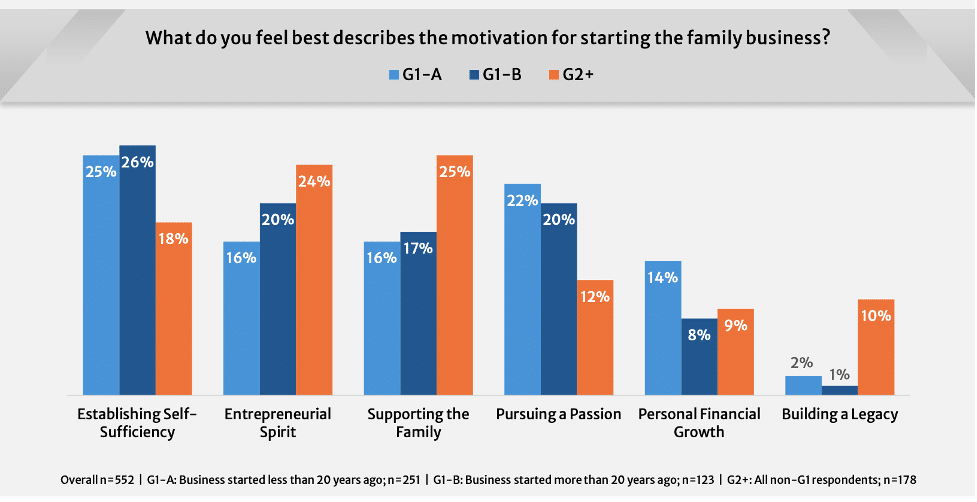A recent survey conducted by the First Bank Center for Family-Owned Businesses aimed at uncovering what’s on the minds of family business owners. When family business owners were asked about the roots of their family business, different generations told different stories. The research report states:
“A family business’ history and origin story can be a powerful asset for brand identity development, customer relationship building, and competitive differentiation. But where G1 respondents pointed to “Establishing Self-Sufficiency” and “Pursuing a Passion” as their top motivators for starting the family business, G2+ indicated they thought “Supporting the Family” and “Entrepreneurial Spirit” were top motivators. This disconnect highlights the importance of cross-generational communication to ensure the family business’ story is told with consistency and clarity.”

*A qualified respondent is currently involved with a family business and is a family member.
Key Findings Report Citations:
1) “What Is A Customer Journey Map And Why Are They Important?”, LinkedIn Blog, 2021 (Link) 2) “Top 5 Things Millennials Want In the Workplace in 2021”, Great Place to Work, 2021 (Link) 3) “From Trust to Impact”, 10th Global Family Business Survey, PWC, 2021 (Link)
The first generation of a family-owned business holds a distinctive narrative regarding the establishment of their company. This survey sheds light on the contrasting business motivations that exist across different generations within family-owned enterprises.
For first-generation business owners, establishing self-sufficiency and pursuing a passion ranked as their biggest motivation for starting their business. While successive generations, joining the already established business ranked these categories much lower. What we learn from this is because the 2nd and following generations inherit an already established business, they don’t identify themselves as establishing self-sufficiency. Because this group isn’t the founding generation, their “passion” isn’t identified with the business but rather with supporting their family and its legacy.
These key foundational differences over time can lead to a disconnect in the brand identity, business differentiators, and customer relations when the founding generation passes ownership to the next.
So what can family business owners do to ensure their brand story, culture, and service stays consistent when the business is passed on to the next generation? A key best practice for keeping a brand identity and position consistent is developing a brand guidelines document.
Brand Guidelines: A brand guidelines document for a business establishes a “true north” from which every touchpoint is developed. This foundational document is crucial for multi-generational businesses.
The brand guidelines should include the following information:
- Who We Are: Establish your brand promise and company culture, which includes your shared values, attitudes, behaviors, and standards that make up your work environment.
- Who We Serve: Identify your ideal customers and the benefits they gain from your company. This spans beyond products and services to include the unique approach and support your customer experiences.
- Behind the Brand: Your founding brand story is an asset that should be established within your guidelines to ensure it isn’t lost with future generations.
- Why We Exist: The passion behind the founding of your business is the key reason your business exists. Whether it was to fill a gap in the marketplace or to provide an innovation to current problems, why your business exists matters.
- Our Differentiators: Regardless of the industry, every single business has its own approach to providing solutions to its customers. Identifying your unique differentiators and highlighting them within your branding and marketing strategies is one key component to setting your business apart from the competition. Ensuring those differentiators are not lost with future generations can be established when they are built into your brand guidelines and positioning.
- Company Persona & Ethics: Businesses typically develop a customer persona (aka avatar) but very few consider what their own persona is. Your company persona aligns very closely with your company culture. How you behave as a collective business – integrity, honesty, and transparency – are all part of your company persona and ethics. These attributes are a vital part of your business legacy and the loyalty you hold with your customers. It is important to pass your company persona down to the next generation owner as part of your business brand identity.
- Brand Tone & Personality: This is one of the most important touchpoints for a business, yet is an area that is rarely trained on or placed in a category as part of a business’s brand identity. Your guidelines should include a description and examples of your brand tone and personality to ensure a consistent voice, attitude, and approach to client care.
- Core Brand Traits: Create benchmarks to set expectations for team members on how they interact with customers. Examples could include: Respectful, but not stiff; Patient, but not a push-over; Fun, but not immature. The goal is to provide guidelines for the business trait that is expected from team members as they work with each other and customers.
- How We Look: The visual representation of your brand reaches far beyond just your logo. The images you use on your website, social media, advertisements, enews, and so on to support your content are just as important as your logo because images create an emotion and they tell a story. The visuals you use to support and position your brand become a part of your story to the viewer. Creating guidelines for the types of visuals that are appropriate and acceptable to represent your brand as well as how your company logo can and can’t be used is a vital part of protecting your brand asset while aiding in strengthening its positioning.
Understanding and documenting your brand is the foundation for effective brand growth and longevity. Your brand guidelines define how you function as a company and support brand consistency throughout business succession. Clearly defining and documenting your brand positioning establishes a strategic framework that guides every branding decision. Your documented brand guidelines ensure consistency and alignment across all touchpoints, from logo design and messaging to marketing campaigns and customer engagements. It empowers you to create compelling narratives, forge emotional connections, and stand out in a crowded market. A well-defined brand guideline serves as the North Star, guiding the development of resonant and impactful branding strategies that foster customer loyalty, drive business success, and support a lasting family legacy.
Dive deeper into your brand story and develop your brand guidelines to support and grow your family business.








